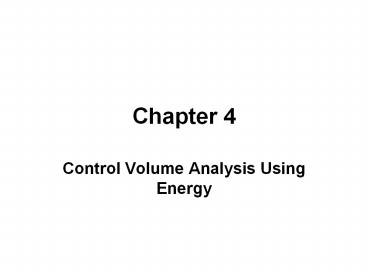Control%20Volume%20Analysis%20Using%20Energy - PowerPoint PPT Presentation
Title:
Control%20Volume%20Analysis%20Using%20Energy
Description:
Chapter 4 Control Volume Analysis Using Energy – PowerPoint PPT presentation
Number of Views:66
Avg rating:3.0/5.0
Title: Control%20Volume%20Analysis%20Using%20Energy
1
Chapter 4
- Control Volume Analysis Using Energy
2
Learning Outcomes
- Demonstrate understanding of key concepts related
to control volume analysis including
distinguishing between steady-state and transient
analysis, distinguishing between mass flow rate
and volumetric flow rate, and the meanings of
one-dimensional flow and flow work. - Apply mass and energy balances to control volumes.
3
Learning Outcomes, cont.
- Develop appropriate engineering models for
control volumes, with particular attention to
analyzing components commonly encountered in
engineering practice such as nozzles, diffusers,
turbines, compressors, heat exchangers,
throttling devices, and integrated systems that
incorporate two or more components. - Use property data in control volume analysis
appropriately.
4
Mass Rate Balance
5
Mass Rate Balance
In practice there may be several locations
on the boundary through which mass enters or
exits. Multiple inlets and exits are accounted
for by introducing summations
Eq. 4.2 is the mass rate balance for control
volumes with several inlets and exits.
6
Mass Flow Rate(One-Dimensional Flow)
- Flow is normal to the boundary at locations where
mass enters or exits the control volume. - All intensive properties are uniform with
position over each inlet or exit area (A) through
which matter flows.
7
Mass Rate Balance(Steady-State Form)
- Steady-state all properties are unchanging in
time. - For steady-state control volume, dmcv/dt 0.
8
Energy Rate Balance
9
Evaluating Work for a Control Volume
The expression for work is
(Eq. 4.12)
10
Control Volume Energy Rate Balance(One-Dimensiona
l Flow Form)
Using Eq. 4.12 in Eq. 4.9
For convenience substitute enthalpy, h u pv
11
Control Volume Energy Rate Balance(One-Dimensiona
l Flow Form)
In practice there may be several locations
on the boundary through which mass enters or
exits. Multiple inlets and exits are accounted
for by introducing summations
Eq. 4.15 is the accounting balance for the
energy of the control volume.
12
Control Volume Energy Rate Balance(Steady-State
Form)
- Steady-state all properties are unchanging in
time. - For steady-state control volume, dEcv/dt 0.
13
Control Volume Energy Rate Balance(Steady-State
Form, One-Inlet, One-Exit)
- Many important applications involve one-inlet,
one-exit control volumes at steady state. - The mass rate balance reduces to
.
14
Nozzles and Diffusers
- Nozzle a flow passage of varying cross-sectional
area in which the velocity of a gas or liquid
increases in the direction of flow. - Diffuser a flow passage of varying
cross-sectional area in which the velocity of a
gas or liquid decreases in the direction of flow.
15
Nozzle and Diffuser Modeling
- If the change in potential energy from inlet to
exit is negligible, g(z1 z2) drops out. - If the heat transfer with surroundings is
negligible, - drops out.
?
16
Turbines
- Turbine a device in which power is developed as
a result of a gas or liquid passing through a set
of blades attached to a shaft free to rotate.
17
Turbine Modeling
- If the change in kinetic energy of flowing matter
is negligible, ½(V12 V22) drops out. - If the change in potential energy of flowing
matter is negligible, g(z1 z2) drops out. - If the heat transfer with surroundings is
negligible, - drops out.
18
Compressors and Pumps
- Compressors and Pumps devices in which work is
done on the substance flowing through them to
change the state of the substance, typically to
increase the pressure and/or elevation. - Compressor substance is gas
- Pump substance is liquid
19
Compressor and Pump Modeling
- If the change in kinetic energy of flowing matter
is negligible, ½(V12 V22) drops out. - If the change in potential energy of flowing
matter is negligible, g(z1 z2) drops out. - If the heat transfer with surroundings is
negligible, - drops out.
20
Heat Exchangers
- Direct contact A mixing chamber in which hot and
cold streams are mixed directly. - Tube-within-a-tube counterflow A gas or liquid
stream is separated from another gas or liquid by
a wall through which energy is conducted. Heat
transfer occurs from the hot stream to the cold
stream as the streams flow in opposite directions.
21
Heat Exchanger Modeling
(Eq. 4.18)
- If the kinetic energies of the flowing streams
are negligible, (Vi2/2) and (Ve2/2) drop
out. - If the potential energies of the flowing streams
are negligible, gzi and gze drop out. - If the heat transfer with surroundings is
negligible, - drops out.
?
22
Throttling Devices
- Throttling Device a device that achieves a
significant reduction in pressure by introducing
a restriction into a line through which a gas or
liquid flows. Means to introduce the restriction
include a partially opened valve or a porous plug.
23
Throttling Device Modeling
- If the change in kinetic energy of flowing matter
upstream and downstream of the restriction is
negligible, ½(V12 V22) drops out. - If the change in potential energy of flowing
matter is negligible, g(z1 z2) drops out. - If the heat transfer with surroundings is
negligible, - drops out.
?
24
System Integration
- Engineers creatively combine components to
achieve some overall objective, subject to
constraints such as minimum total cost. This
engineering activity is called system integration.
- The simple vapor power plant of Fig 4.16 provides
an illustration.
25
The Mass Balance (Transient Analysis)
- Transient state changes with time.
- Integrate mass rate balance (Eq. 4.2) from time 0
to a final time t.
- where
- mi is amount of mass entering the control volume
through inlet i, from time 0 to t. - me is amount of mass exiting the control volume
through exit e, from time 0 to t.
26
The Energy Balance (Transient Analysis)
- Integrate energy rate balance (Eq. 4.15),
ignoring the effects of kinetic and potential
energy, from time 0 to a final time t.
When the specific enthalpies at inlets and exits
are constant with time, this becomes































